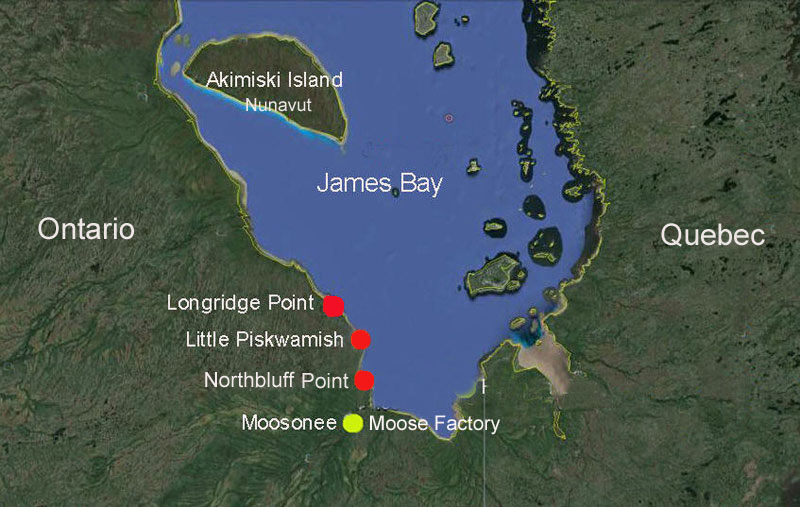|
James Bay Shorebird
Project 2017 |
|
|
|
Longridge Point from 30 July
to 14 August 2017 - Page 1 of 6 |
|
 |
|
Molting adult male
Hudsonian Godwit (left) and fresh juvenile Marbled Godwit on 2
August 2017. |
|
|
|
 |
|
In summer 2017,
we had three shorebird camps in southern James Bay: Longridge
Point, Little Piskwamish Point and Northbluff Point (aka North
Point). I was at Longridge from 30 July to 14 August 2017. |
|
|
|
Project partners
are: Environment and
Climate Change Canada's Canadian Wildlife Service,
Ontario Ministry of Natural Resources and
Forestry (OMNRF), Bird
Studies Canada, and Trent University,
with a larger conservation initiative involving James Bay First
Nations and Nature Canada. |
|
I thank an anonymous donor for
purchasing camp supplies. |
|
|
|
Longridge Point at High Tide |
|
 |
|
Longridge camp is in the boreal forest
about 5.7 km from the tip of Longridge. James Bay's extensive tidal
mudflats and myriad tidal pools provide excellent habitat for
migrating shorebirds to fatten for long southbound migrations. This
is the 9th year of the James Bay Shorebird Project. Many thanks to
the Moose Cree owners for renting us their comfortable camp. |
|
|
|
Daily Shorebird Surveys and Red
Knot Resights |
|
 |
 |
|
Survey crew: Mark
Dorriesfield, Anne Blondin (also invertebrate sampling) and Jean
Iron on Longridge Point |
|
|
|
 |
|
Daily we surveyed a section of coast and
resighted Red Knot flags. This green flag HLK is from the United
States. Red Knots fatten on James Bay before migrating to South
America. Adult Red Knot in worn breeding plumage on 3 August 2017.
Click on photo above or this link for Red Knots feeding. |
|
|
|
 |
|
Adult Red Knot (left)
with juvenile Red Knot on right. 8 August 2017. We saw our first
juvenile on 3 August 2017. |
|
|
|
 |
|
Semipalmated Sandpipers are a
priority species. High count was 5299 on 12 August. Above is a
juvenile Semipalmated Sandpiper on 8 August 2017. |
|
|
|
 |
|
White-rumped
Sandpipers are a priority species again this year. High count was
7892 on 8 August 2017. Above is a molting adult on 4 August 2017. |
|
|
|
 |
|
Dunlin and
White-rumped Sandpipers resting at high tide on 4 August 2017 |
|
|
|
 |
|
Adult Dunlin molting
into winter plumage, note wing molt, on 12 August 2017. |
|
|
|
 |
|
Semipalmated Plovers
are a priority species for the project. Above is an adult on 1
August 2017. |
|
|
|
 |
|
Juvenile Semipalmated
Plover on 7 August 2017. We saw our first juvenile on 4 August. |
|
|
|
VIDEO: Panorama of Longridge bay and the Wrack of kelp (seaweed),
which attracted the shorebirds |
|
|
|
End of page 1.
Now
go to page 2. |
| |
|
|